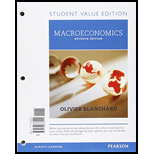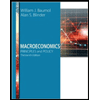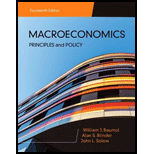
a)
The current U.S.
a)
Explanation of Solution
It is False because of rising
Introduction: A trade deficit occurs when the imports of a nation surpass its exports for a given period of time. The demand for import rises due to many factors like increase in the preference for the particular product, low cost of producing output as compare with home country.
b)
The national identity implies that budget deficits cause trade deficits is true or false
b)
Explanation of Solution
It is False Since an increase in the budget deficit would lead to an increase in the trade deficit, we cannot infer from the identity of the
Introduction: The identity of national income says that consumption expenditures, plus investment expenditures, plus government spending, plus exports, minus imports, that provides give
c)
The opening the economy to trade tends to increase the multiplier because an increase in expenditure leads to more exports is true or false.
c)
Explanation of Solution
It is False because Expenditure changes will now be shared between domestic and international products.
Introduction: An impact in economics where an increase in spending causes an increase in national income and consumption that is greater than the amount spent initially. For instance, if a business builds a factory, it will hire construction workers and their suppliers as well as those employed in the factory.
d)
If the trade deficit is equal to zero, then the domestic demand for goods and the demand for domestic goods are equal is true or false.
d)
Explanation of Solution
It is true, if the trade deficit is equal to zero, then the domestic demand for goods and the demand for domestic goods are equal. Countries have a favorable
Introduction: A trade deficit occurs, when a nation imports more than it exports. A trade gap is neither necessarily positive nor poor inherently. A trade deficit may be a symbol of a healthy economy, and may lead to stronger
e)
A real
e)
Explanation of Solution
It is False as Econometric evidence suggests that a real depreciation does not result in immediate trade balance change. Trade balance usually increases six to twelve months after a true depreciation.
Introduction: Domestic currency depreciation means a decline in the value of the domestic currency in foreign currency terms.
f)
A small open economy can reduce its trade deficit through fiscal contraction at a small cost in output than can a large open economy is true or false.
f)
Explanation of Solution
It is true; a small open economy can minimize its trade deficit through fiscal contraction at a smaller cost in output than can a large open economy.
Introduction: In a small open economy, equilibrium occurs when saving equals investment; however, there is equilibrium in a open large economy when saving less desired investment equals net exports.
g)
The experience of the United States in the 1990s shows that real exchange rate appreciations lead to trade deficits and real exchange rate depreciations lead to trade surpluses is true or false.
g)
Explanation of Solution
It is true, the history of the United States in the 1990s indicates that real currency appreciations lead to trade deficits and real depreciation of the exchange rate leads to trade surpluses.
Introduction: In general terms, appreciation reflects an improvement in the value of an asset over time. The rise may occur for a variety of reasons, including increased demand or declining supply, or due to inflation or interest rate changes.
h)
The decline in real income can lead to a decline in imports and thus a trade surplus is true or false.
h)
Explanation of Solution
It is true; a decline in real income can lead to a decline in imports because people prefer to buy more when income of the people increases where as fall in real income discourage to purchase and when a country reduce the volume of import then it can have a trade surplus foe a home country.
Introduction: A trade surplus is one of the economic indicator that reflect a healthy trade balance, in which exports of a nation outweigh its imports.
Want to see more full solutions like this?
Chapter 18 Solutions
Macroeconomics, Student Value Edition Plus MyLab Economics with Pearson eText -- Access Card Package (7th Edition)
- Your marketing department has identified the following customer demographics in the following table. Construct a demand curve and determine the profit maximizing price as well as the expected profit if MC=$1. The number of customers in the target population is 10,000. Use the following demand data: Group Value Frequency Baby boomers $5 20% Generation X $4 10% Generation Y $3 10% `Tweeners $2 10% Seniors $2 10% Others $0 40%arrow_forwardYour marketing department has identified the following customer demographics in the following table. Construct a demand curve and determine the profit maximizing price as well as the expected profit if MC=$1. The number of customers in the target population is 10,000. Group Value Frequency Baby boomers $5 20% Generation X $4 10% Generation Y $3 10% `Tweeners $2 10% Seniors $2 10% Others $0 40% ur marketing department has identified the following customer demographics in the following table. Construct a demand curve and determine the profit maximizing price as well as the expected profit if MC=$1. The number of customers in the target population is 10,000.arrow_forwardTest Preparation QUESTION 2 [20] 2.1 Body Mass Index (BMI) is a summary measure of relative health. It is calculated by dividing an individual's weight (in kilograms) by the square of their height (in meters). A small sample was drawn from the population of UWC students to determine the effect of exercise on BMI score. Given the following table, find the constant and slope parameters of the sample regression function of BMI = f(Weekly exercise hours). Interpret the two estimated parameter values. X (Weekly exercise hours) Y (Body-Mass index) QUESTION 3 2 4 6 8 10 12 41 38 33 27 23 19 Derek investigates the relationship between the days (per year) absent from work (ABSENT) and the number of years taken for the worker to be promoted (PROMOTION). He interviewed a sample of 22 employees in Cape Town to obtain information on ABSENT (X) and PROMOTION (Y), and derived the following: ΣΧ ΣΥ 341 ΣΧΥ 176 ΣΧ 1187 1012 3.1 By using the OLS method, prove that the constant and slope parameters of the…arrow_forward
- QUESTION 2 2.1 [30] Mariana, a researcher at the World Health Organisation (WHO), collects information on weekly study hours (HOURS) and blood pressure level when writing a test (BLOOD) from a sample of university students across the country, before running the regression BLOOD = f(STUDY). She collects data from 5 students as listed below: X (STUDY) 2 Y (BLOOD) 4 6 8 10 141 138 133 127 123 2.1.1 By using the OLS method and the information above derive the values for parameters B1 and B2. 2.1.2 Derive the RSS (sum of squares for the residuals). 2.1.3 Hence, calculate ô 2.2 2.3 (6) (3) Further, she replicates her study and collects data from 122 students from a rival university. She derives the residuals followed by computing skewness (S) equals -1.25 and kurtosis (K) equals 8.25 for the rival university data. Conduct the Jacque-Bera test of normality at a = 0.05. (5) Upon tasked with deriving estimates of ẞ1, B2, 82 and the standard errors (SE) of ẞ1 and B₂ for the replicated data.…arrow_forwardIf you were put in charge of ensuring that the mining industry in canada becomes more sustainable over the course of the next decade (2025-2035), how would you approach this? Come up with (at least) one resolution for each of the 4 major types of conflict: social, environmental, economic, and politicalarrow_forwardHow is the mining industry related to other Canadian labour industries? Choose one other industry, (I chose Forestry)and describe how it is related to the mining industry. How do the two industries work together? Do they ever conflict, or do they work well together?arrow_forward
- What is the primary, secondary, tertiary, and quaternary levels of mining in Canada For each level, describe what types of careers are the most common, and describe what stage your industry’s main resource is in during that stagearrow_forwardHow does the mining industry in canada contribute to the Canadian economy? Describe why your industry is so important to the Canadian economy What would happen if your industry disappeared, or suffered significant layoffs?arrow_forwardWhat is already being done to make mining in canada more sustainable? What efforts are being made in order to make mining more sustainable?arrow_forward
- What are the environmental challenges the canadian mining industry face? Discuss current challenges that mining faces with regard to the environmentarrow_forwardWhat sustainability efforts have been put forth in the mining industry in canada Are your industry’s resources renewable or non-renewable? How do you know? Describe your industry’s reclamation processarrow_forwardHow does oligopolies practice non-price competition in South Africa?arrow_forward

 Macroeconomics: Private and Public Choice (MindTa...EconomicsISBN:9781305506756Author:James D. Gwartney, Richard L. Stroup, Russell S. Sobel, David A. MacphersonPublisher:Cengage Learning
Macroeconomics: Private and Public Choice (MindTa...EconomicsISBN:9781305506756Author:James D. Gwartney, Richard L. Stroup, Russell S. Sobel, David A. MacphersonPublisher:Cengage Learning Economics: Private and Public Choice (MindTap Cou...EconomicsISBN:9781305506725Author:James D. Gwartney, Richard L. Stroup, Russell S. Sobel, David A. MacphersonPublisher:Cengage Learning
Economics: Private and Public Choice (MindTap Cou...EconomicsISBN:9781305506725Author:James D. Gwartney, Richard L. Stroup, Russell S. Sobel, David A. MacphersonPublisher:Cengage Learning Principles of Economics 2eEconomicsISBN:9781947172364Author:Steven A. Greenlaw; David ShapiroPublisher:OpenStax
Principles of Economics 2eEconomicsISBN:9781947172364Author:Steven A. Greenlaw; David ShapiroPublisher:OpenStax Macroeconomics: Principles and Policy (MindTap Co...EconomicsISBN:9781305280601Author:William J. Baumol, Alan S. BlinderPublisher:Cengage Learning
Macroeconomics: Principles and Policy (MindTap Co...EconomicsISBN:9781305280601Author:William J. Baumol, Alan S. BlinderPublisher:Cengage Learning





